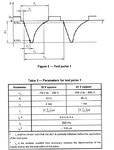Gaurav_1806
Newbie level 4
Hello,
I am facing a field issue in on of my product, the input signal capacitor used for ESD protection gets burned out. The capacitor used is MLCC type, 100nF, 50V and 0603 package.
I think so the due to the high transient voltage on the input lines this capacitor may be getting degraded and over the period of time is getting burn out.
So, my confusion is to how to determine or calculate the maximum supported rated voltage will be need to sustain these automotive pulses.
I am facing a field issue in on of my product, the input signal capacitor used for ESD protection gets burned out. The capacitor used is MLCC type, 100nF, 50V and 0603 package.
I think so the due to the high transient voltage on the input lines this capacitor may be getting degraded and over the period of time is getting burn out.
So, my confusion is to how to determine or calculate the maximum supported rated voltage will be need to sustain these automotive pulses.
